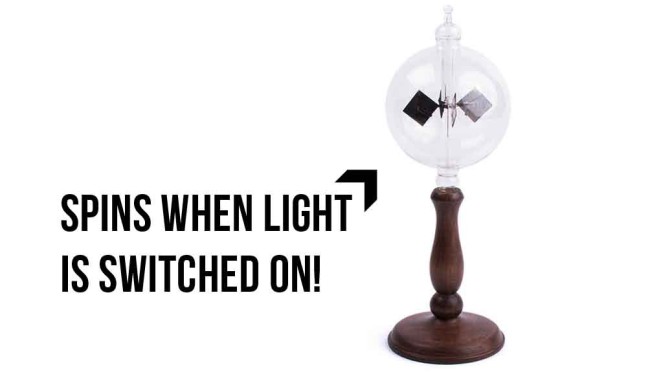By Anupum Pant
Tim is a 71-year-old eccentric who has been collecting interesting toys for 50 years now. Today he has a collection of around 250,000 absurd toys in suitcases, labeled and stacked in a room from the floor to the ceiling. He shows them off in a Youtube channel regularly. I almost never miss any of his toys. Usually most the toys he displays amaze you, but do not blow off your mind. The last one did.
Before this, I had not known that light can push or move a physical object. So, I decided to investigate a bit.
The Extraordinary Toy
In his last video, he showed off a beautiful glass bulb mounted on a wooden stand, that he says has been made by some German company. The bulb has a very good vacuüm (not complete vacuüm, just enough to not create unnecessary drag for the vanes) and encloses a fan-like structure that starts rotating when a bright light is switched on near it. Some people call it the light mill – like the wind mill moves with the wind, this one moves when photons hit it. If give enough time, the mill can accelerate to really good speeds (at thousands of rounds per minute). Watch the video below. [Video]
Theories on how a radiometer really works
The device, a special kind of radiometer, was invented around 140 years back in the year 1873, by Victorian experimenter Sir William Crookes to measure the radiant energy of heat or light. It has four vanes mounted at the edge of four stiff wires to make a fan, each of which has a black side and a silvered side. All of this is enclosed in a bulb which is evacuated enough to not cause drag due to air. In complete vacuüm the vanes move in an opposite direction, but that experiment is really difficult to recreate!
- When light is turned on, the fan moves in a way that makes it look as if light is pushing away the black colored side. The theory of photons pushing the black side was accepted initially. But soon a problem was seen with the theory. If light is absorbed at the blackened side and reflected at the silvered side, the fan should be moving in the opposite direction.
- Then came in the other explanation which explained that the heated black side due to absorbed radiation rarefied the air near the black side and hence caused the gas to rush in and push that side. The greater the heat, the more this back side would get pushed and it would spin faster. Later even this theory was proved to be wrong. But, Britannica, till date decides to go with this explanation – to some extent this theory goes in the right direction, you will see why…
- One more theory claimed that the heat evaporated the impurities on the black side, whose force made it spin.
How the radiometer really works?
The correct explanation was given by a prominent Anglo-Irish innovator, Osbourne Reynolds. He explained it by mentioning a porous plate, where the air inside the holes would flow from the colder sides to the warmer side (obviously) and make the vanes spin in the opposite direction. He called it “Thermal Transpiration” – makes sense and is easy to understand. But the vanes here are not porous. So…
He said that “Thermal Transpiration” in the vanes takes place at the edge of the vanes and not the faces. Think of edges as small pores, he said.
Due to a temperature gradient formed, the air starts moving along the surface from colder to the warmer side through the edges. The net pressure difference around the vane is created which pushes it in a direction that is away from warmer air and towards the colder air – makes sense for the apparatus.
This is the reason, if it is cooled, it moves in the opposite direction.





